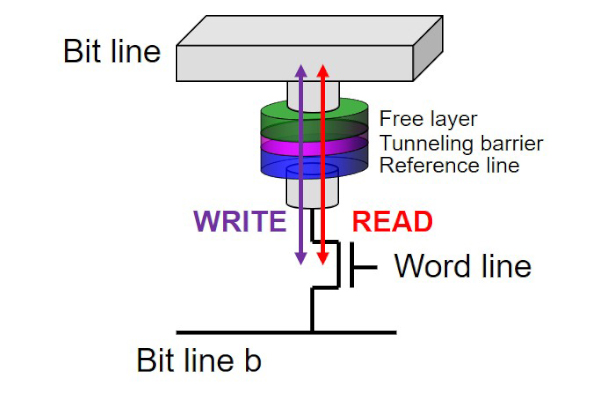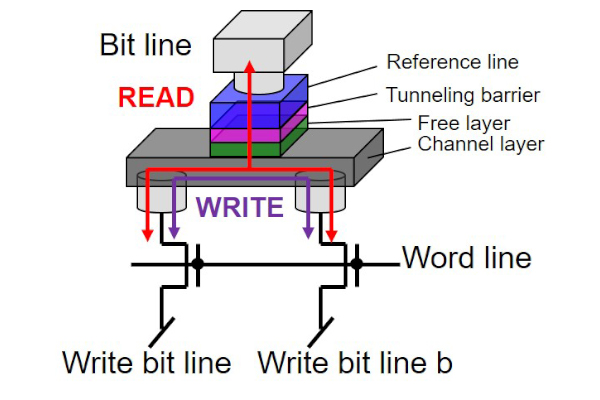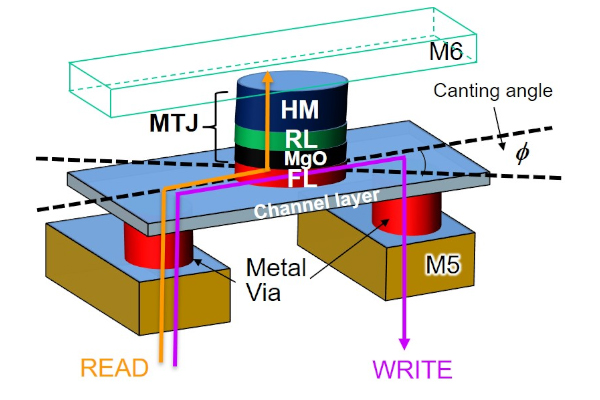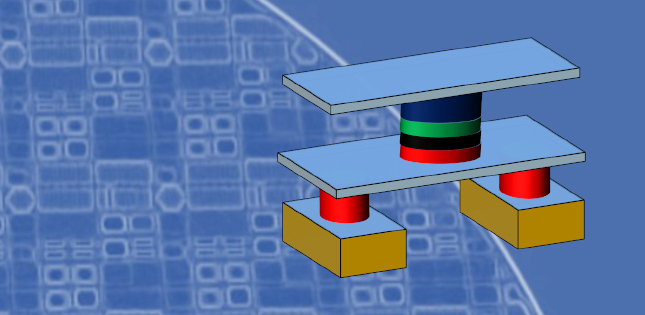Researchers at Tohoku University have announced the demonstration of high-speed spin-orbit-torque (SOT) magnetoresistive random access memory cell compatible with 300 mm Si CMOS technology.
The demand for low-power and high-performance integrated circuits (ICs) has been increasing as artificial intelligence (AI) and Internet-of-Things (IoT) devices become more widely adopted. With the present ICs, purely CMOS-based memories such as embedded Flash memory (eFlash) and static random-access memory (SRAM) are responsible for a high proportion of power consumption. In order to lower power consumption while keeping high performance, magnetoresistive random access memories (MRAMs) have been intensively developed. Spin-transfer torque MRAMs (STT-MRAMs) are the most intensively developed MRAM. Major semiconductor companies have now announced that they are ready for mass production of STT-MRAM for eFlash replacement.

Schematic of STT-MRAM cell (Two Terminal Device) ⒸCIES, Tohoku University
Researchers are aiming to replace SRAM with MRAM. For SRAM replacement, MRAM must achieve high-speed operation above 500 MHz. To meet the demand, an alternative MRAM, so-called spin-orbit torque MRAM (SOT-MRAM) was proposed, which has several advantages for high-speed operation. Because of these advantages, SOT-MRAM has also been developed; however, most laboratory studies focus on the fundamentals of SOT devices. To realize SRAM replacement by SOT-MRAM, it is required to demonstrate high-performance of SOT-MRAM memory cell on 300mm CMOS substrate. In addition, it is necessary to develop the integration process for SOT-MRAM, e.g., thermal tolerance against 400°C annealing, which is a requirement of the standard CMOS back-end-of-line process.

Schematic of SOT-MRAM cell (Three Terminal Device) ⒸCIES, Tohoku University
The research team led by Professors Tetsuo Endoh and Hideo Ohno - the current president of Tohoku University - has developed an integration process for SOT devices compatible with 55nm CMOS technology and fabricated SOT devices on 300mm CMOS substrates. The newly developed SOT device has simultaneously achieved high-speed switching down to 0.35 ns and a sufficiently high thermal stability factor (E/kBT=70) for the high-speed non-volatile memory applications with robustness against annealing at 400°C. Based on this achievement, the research team has integrated the SOT device with CMOS transistors and finally demonstrated high-speed operation in complete SOT-MRAM memory cells.

Schematic view of the canted SOT-MRAM cell. ⒸCIES, Tohoku University
These achievements have addressed the issues to make SOT-MRAM practical for commercial applications and thus offer a way to replace SRAM with SOT-MRAM, which will contribute to the realization of high-performance electronics with low-power consumption.
Results will be presented at the 2019 IEEE International Electron Devices Meeting in San Francisco, December 7-11, 2019.
- Publication Details:
Title: First demonstration of field-free SOT-MRAM with 0.35 ns write speed and 70 thermal stability under 400°C thermal tolerance by canted SOT structure and its advanced patterning/SOT channel technology
Authors: H. Honjo, T. V. A. Nguyen, T. Watanabe, T. Nasuno, C. Zhang, T. Tanigawa, S. Miura, H. Inoue, M. Niwa, T. Yoshiduka, Y. Noguchi, M. Yasuhira, A. Tamakoshi, M. Natsui, Y. Ma, H. Koike, Y. Takahashi, K. Furuya, H. Shen, S. Fukami, H. Sato, S. Ikeda, T. Hanyu, H. Ohno, and T. Endoh
Contact:
Tetsuo Endoh
Center for Innovative Integrated Electronic Systems, Tohoku University
Email: tetsuo.endoh cies.tohoku.ac.jp
cies.tohoku.ac.jp


